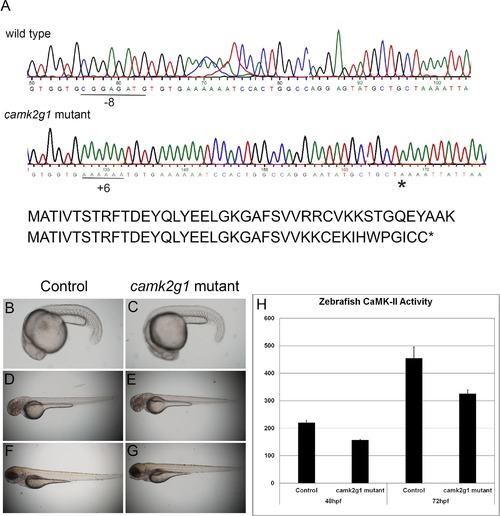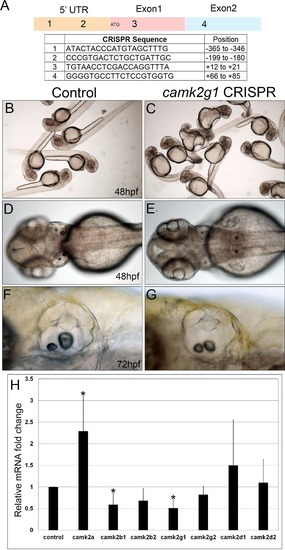- Title
-
Genetic compensation of γ CaMKII, an evolutionarily conserved gene
- Authors
- Rothschild, S.C., Ingram, S.R., Lu, F.I., Thisse, B., Thisse, C., Parkerson, J.A., Tombes, R.M.
- Source
- Full text @ Gene
|
Characterization of camk2g1 mutant zebrafish. Electropherograms of exon2 in wild type and camk2g1 “TALEN” mutant embryos show a loss of 8 nts from wild type (−8) and gain of 6 nts in camk2g1 mutants (+6) leading to a premature stop codon shown for the predicted amino acid sequence from the start codon (A). Camk2g1 mutants appear phenotypically normal at 22 s (B, C), 48hpf (D, E) and 4dpf (F, G). CaMKII specific activity (nmoles/min/mg) is reduced by 25–30% at 48hpf and 72hpf in camk2g1 mutants (H). PHENOTYPE:
|
|
Development of camk2g1 mutants injected with camk2g1 MO. Control, camk2g1 morphants, camk2g1 mutants, and camk2g1 mutants injected with the camk2g1 MO were imaged at 48hpf (A-L). Camk2g1 morphants display curved tails (D) smaller otoliths (E) and defects in cloacal morphology (F). Control embryos, camk2g1 mutants, and camk2g1 mutants injected with the camk2g1 MO do not display such morphological defects. CaMKII activity assays of 72hpf embryos reveal up to twice the reduction in CaMKII activity in camk2g1 morphants in a dose-dependent manner, when compared to camk2g1 mutants (M). PHENOTYPE:
|

ZFIN is incorporating published figure images and captions as part of an ongoing project. Figures from some publications have not yet been curated, or are not available for display because of copyright restrictions. PHENOTYPE:
|

ZFIN is incorporating published figure images and captions as part of an ongoing project. Figures from some publications have not yet been curated, or are not available for display because of copyright restrictions. EXPRESSION / LABELING:
PHENOTYPE:
|
|
Morphological defects in camk2g1 CRISPR embryos. 4 gRNAs were designed against camk2g1 to generate G0 camk2g1 CRISPR embryos (A). G0 camk2g1 CRISPR embryos show variable phenotypes with shortened anterior posterior axis and tail curvatures evident at 48hpf (C) compared to control embryos (B). Kidney cysts were absent in control embryos (D) and developed by 48hpf in CRISPR embryos (E, asterisks). Otoliths were smaller in camk2g1 CRISPR embryos compared to controls (F, G). qPCR of CaMKII genes in camk2g1 CRISPR embryos at 24hpf relative to ef1α (H). Dorsal, anterior to the left (D, E). Lateral, anterior to the left (F, G). * p < 0.05. |

ZFIN is incorporating published figure images and captions as part of an ongoing project. Figures from some publications have not yet been curated, or are not available for display because of copyright restrictions. PHENOTYPE:
|

ZFIN is incorporating published figure images and captions as part of an ongoing project. Figures from some publications have not yet been curated, or are not available for display because of copyright restrictions. PHENOTYPE:
|

ZFIN is incorporating published figure images and captions as part of an ongoing project. Figures from some publications have not yet been curated, or are not available for display because of copyright restrictions. PHENOTYPE:
|
Reprinted from Gene, 742, Rothschild, S.C., Ingram, S.R., Lu, F.I., Thisse, B., Thisse, C., Parkerson, J.A., Tombes, R.M., Genetic compensation of γ CaMKII, an evolutionarily conserved gene, 144567, Copyright (2020) with permission from Elsevier. Full text @ Gene



